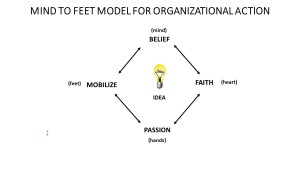How Far Can You See?
If you’ve spent any time in organizational leadership, regardless of whether the organization is a company or a family, I’m sure you’ve experienced the common struggle all of us in the business have faced when it comes to breaking through inertia and turning ideas into action.
Most of you have probably already guessed that communication is the key. You’re right…but it’s not that simple. It’s generally not the case that one mighty act of oration turns an organization on a dime. Given that organizations are made of individuals, my observation from years in leadership is that there is a specific and sequential path that plants an idea in the minds of people and eventually finds its way to the feet where people move out and accomplish great deeds. Very succinctly, I’ve named this idea “The Mind To Feet Model For Organizational Action.”
For an organization to move forward…on a project or a culture change…progress starts in the mind with a sense of belief. The human mind typically needs some mechanism to connect the present state to the future in a way that triggers the response…”this is real.” In this early stage of the model, the mix of logic to emotion will likely be slanted to logic so that over time the “this is real” response is repeated enough…and debated enough…to gain widespread acceptance.
Faith is derived from a connection of the mind to the heart. Where belief is a conviction that something is possible…faith is a conviction that something is repeatable. Where it’s possible to move from belief with an idea, faith typically needs something tangible to set the idea that not only is something possible…it’s possible for us. Demonstrations, prototypes, and experiments are all examples of evidence that can move the position of an organization from “this is real” to “this is repeatable.”
Passion for an idea comes from the hands when the membership of an organization, through a collaborative process, can start to shape the future through infusing their own ideas and creativity into a concept. We’ve discussed in several previous posts how ownership of an idea can ignite the passion of people to find fulfillment in their action. Collaborative approaches can sometimes take more time, sometimes they can be a little messy, but generally the end result is a better product with a higher level of commitment.
Mobilization comes from the feet and comes from one of the strongest of human emotions…the notion that through your efforts, you’ve made life better for another human being. Clearly, we are talking about the ability to communicate “why” in a way that goes beyond short term profit. There are many cynics who will disagree with that assertion; but I’m steadfast, again through years of observation, that people truly put “skin in the game” for opportunities to benefit another person. It’s no different in a for-profit enterprise, a civic organization, or in a family. The neatest part of this all is that mobilization, as you can see from the arrows in the model, feeds back to belief…the very beginning…and makes the level of commitment even stronger over time.
You don’t need to look hard to find opportunities to apply this model. If you want to do something meaningful, use this model to plan how you will move an idea from the mind to the feet. It’s not the smoke and mirrors some would have you believe. Use this model that breaks something complex into its individual components and move out on the idea you thought wasn’t possible. It starts with believing…and that starts with you. It’s also what a Critical Doer would…do!
So let me ask you again…how far can you see?
Reminder: you can get automatic updates from The Critical Doer by using the subscription widget at the top of this post. You can also follow on Facebook, Twitter, and Google+. I also encourage you to let me know what you think of the posts or share a story of your own using the comments section or email me directly at [email protected].
